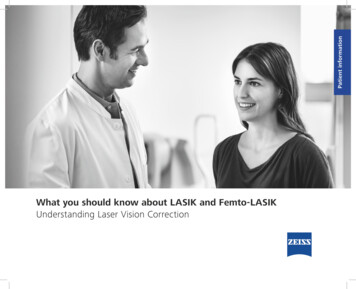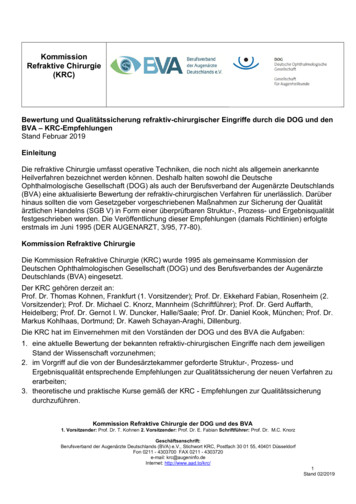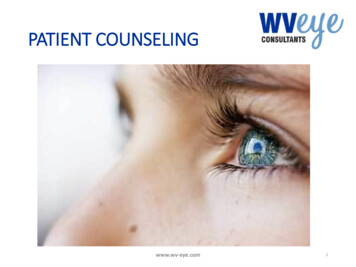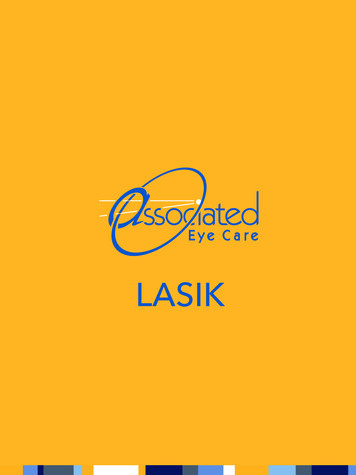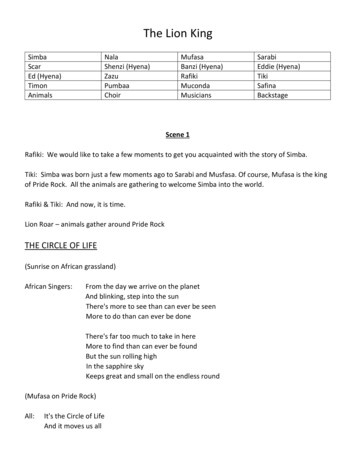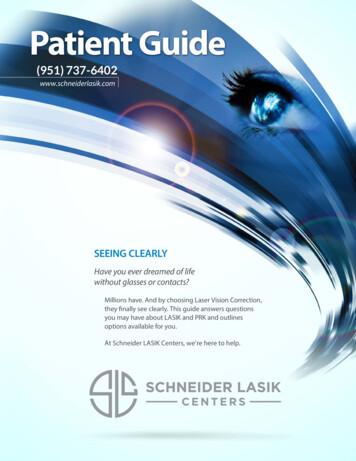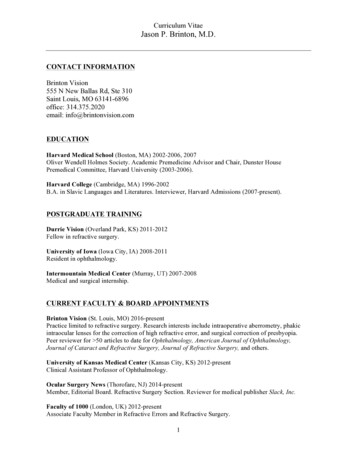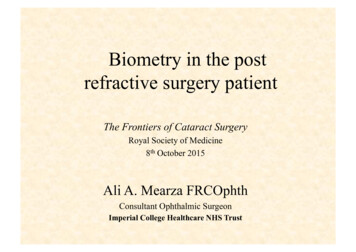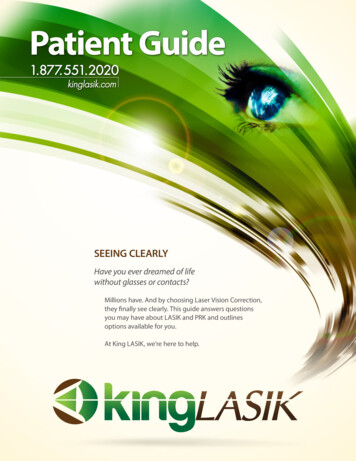
Transcription
Patient Guide1.877.551.2020kinglasik.comSEEING CLEARLYHave you ever dreamed of lifewithout glasses or contacts?Millions have. And by choosing Laser Vision Correction,they finally see clearly. This guide answers questionsyou may have about LASIK and PRK and outlinesoptions available for you.At King LASIK, we’re here to help.
“Life without glasses is great. As a father of three young children, I like being ableto swim and play with the kids without needing glasses. As a busy professional,I no longer have to bother with glasses, contact lenses, solutions or dry eyes.Freedom from glasses and contacts has made it a lot easier to enjoy my life.— DR. JOSEPH KING, Medical Director and former LASIK patient”
HAVE YOU EVER dreamed about life without glasses?Or never having to bother with contacts every day?Playing sports without worrying about expensive glasses or swimming without contacts?Or simply waking up and seeing the alarm clock — without asking what time it is?EVERY YEAR two million people trade in their glasses and contact lensesand enjoy the freedom Laser Vision Correction provides.It’s a big decision and we know you may have many questions so wecreated this guide to help.CAN LASIK HELP YOU?Not everyone can have Laser Vision Correction, or LASIK, so the first stepis to determine if you are a candidate for the procedure. We need toexamine your eyes thoroughly to make sure LASIK is a good fit for youand determine how much we can improve your vision.This guide answers many commonquestions about Laser VisionCorrection. We understand what abig decision it is to undergo LASIK– many of our doctors and staffhave had the procedure done.So if you have any additionalquestions after reading this guide,please call our caring staff at KingLASIK, 1.877.551.2020. We’d behappy to answer your questions!“If you don’t see a regular eye doctor, you simply come in for a freeexam and consultation. This thorough visit helps determine if you are agood candidate and provides us with the information needed for yourprocedure.On this visit, you will meet our medical staff and experience the care andcomfort we provide. You’ll learn about our experienced surgeons and theadvanced technology we use.You may have a few questions before you come in for your initial consultation, so on the next few pages you’ll learn more about how your eyeworks, what you need to know about the LASIK procedure and whatoptions are available.I have always lived an active lifestyle, from high school wrestler to construction worker andfather. At 3 months into my new life without glasses I experience none of the possible sideeffects and see perfectly. In fact at 20/15 vision, I see better than perfectly! I can’t stoptalking about how wonderful the whole experience was and is. I would and dorecommend Dr. King and King LASIK to anyone.— CHIP N.”1
NEARSIGHTED? Farsighted? Do you use reading glasses?HOW GOOD IS YOUR EYESIGHT?CHANCES ARE you are either nearsighted or farsighted with some level of astigmatism.At your initial exam, we will check your eyesight and determine your specific challenges.In most cases, your vision can be improved through Laser Vision Correction.COMMON VISION PROBLEMSTHE EYE works like a camera where light passes through the lens andis focused on the film forming an image. In the eye, light rays passthrough the cornea and lens and then strike the retina where animage forms.THE CORNEA is the clear window at the front of the eye that providesmost of the eye’s focusing power. The lens, which sits inside the eyebehind the pupil, accounts for some of the remaining focusingpower. Together the cornea and lens function to focus light rays ontothe retina so the image is clear. Myopia, hyperopia, and astigmatismare all refractive errors that blur vision.Nearsightedness(myopia): In a myopiceye, the corneal surfaceis too steeply curved,and the light rays arefocused in front of theretina, resulting in ablurry image. To a nearsighted person, distantobjects are blurry andnear objects are clearer.2Farsightedness(hyperopia): In a hyperopic eye, the cornealsurface is too flat, andlight rays are focusedbehind the retina,resulting in a blurryimage. To a farsightedperson, both distant andnear objects are blurry.Astigmatism: In anastigmatic eye, thecornea is shaped morelike a football than abasketball (spherical).Light rays are focused atmultiple points, againcreating a blurry image.Many people withmyopia and hyperopiaalso have astigmatism.Presbyopia: Refers to anatural weakening ofthe eye that comes withaging, usually in the earlyto mid 40’s. A presbyopiceye loses its ability tofocus on near objects,like text in books ornewspapers, and readingglasses usually becomenecessary.
WHAT HAPPENS at your initial visit?MANY people have never been to an ophthalmologist let alone a LASIK practice.But on your visit you’ll find it’s just like going to the eye doctor with a few more tests.We check the overall health of your eyes and stability of your vision to make sure youare an excellent candidate for LASIK — which is one reason we have earned anoutstanding safety record.ON THE DAY of your initial Exam & Consultation youwill fill out the necessary paperwork and then startyour eye and LASIK exam. We conduct a thoroughand complete examination of your eyes, includingsome of the following advanced diagnostic tests.DURING THE EXAMWe will: Measure pupil size Conduct a Wavefront diagnostic evaluation, whichprovides a “fingerprint” of your eye Perform a glaucoma test Conduct a refraction evaluation to determine yourvision stability Perform an Orbscan test to map the shape,contour and thickness of your cornea Dilate your eyes and repeat your refraction tomake sure your vision is stable. (If you have beenreferred to us by your local optometrist, you mayreturn to their care for this exam.) This importantdilation step is sometimes skipped at otherpractices to save time, but we always include it. Retinal evaluationAFTER THE EXAMAfter this initial exam, you will meet with one of ourrefractive counselors and can: Ask additional questions Discuss pricing and affordable financing options Schedule your LASIK procedure if you decideto proceed3
WHAT IS LASIK? What is PRK?PRK is the same laser treatment as LASIK, except that the treatment is applied tothe corneal surface instead of under a flap.WHAT IS LASIK?LASIK (laser-assisted in-situ keratomileusis) is the most popularsurgical procedure to correct vision problems caused by refractiveerror or the failure of the eye to focus light properly. LASIK is a typeof Laser Vision Correction performed by a surgeon using acomputer-controlled laser that emits precise pulses of energy toreshape the cornea.LASIK dramatically reduces the need for glasses or contact lenses bytreating nearsightedness, farsightedness and astigmatism. AfterLASIK, nearly all patients see well enough that they don’t needglasses or contacts for most or all activities requiring distance vision.WHAT IS PRK?PRK STEPSNot everyone is a candidate for LASIK. Your cornea may be too thinor the shape of your eye might not be appropriate for LASIK treatment. But you still have an excellent option to improve your vision:PRK, which stands for photo-refractive keratectomy.After numbing your eyes, asurgeon gently polishes awaysurface cells from the cornea.PRK works in exactly the same general way as LASIK by reshapingthe cornea of the eye so that it better focuses incoming light.Next, the surgeon uses a laser topainlessly reshape the cornea; thesame laser used in LASIK surgery.Both are two-step processes; however, in PRK the first step is different. Whereas LASIK involves providing the laser treatment under aflap, PRK is the application of the laser treatment on the cornealsurface.To help the healing process, atemporary, clear protective lens isplaced over the cornea for four toseven days.“4First time since I was 4 that I don’t need glasses!20/400 to 20/15 which is better than perfect!— JAMIE A.”Between 10% and 15% of ourpatients have PRK; millions havesuccessfully had the procedure.
WHAT HAPPENS in the LASIK procedure?THE LASIK PROCEDURE consists of two steps: First, we create a corneal flap. Then wereshape your cornea to correct your vision. With PRK, there is no flap and the flap creationstep is omitted as the laser treatment is applied directly to the corneal surface.Depending upon your eyesight, several options are available for the first and second steps ofLASIK, and our experienced staff will help you determine which options are the best for you.STEP ONE — Creation of the LASIK FlapFirst, we will numb your eye with local anesthetic drops. Then aLASIKsmall flap is gently created in the outermost surface of the corneato allow access to the corneal bed below. Your surgeon willperform this step of the procedure with one of two instruments:steponeCREATION of the LASIK FLAPOption 1Option 2MICROKERATOME“BLADE”INTRALASE“ALL LASER LASIK”OPTION ONE: MicrokeratomeOPTION TWO: IntraLase “All Laser LASIK”A hand-held oscillating blade positioned on top ofthe cornea creates the flap. Until several years ago,this was the only instrument available to make aLASIK flap, but it is used infrequently today due tothe development of newer technology.A computer-guided laser creates the flap, allowing asurgeon to tailor the size, shape, and depth of thecorneal flap for each of your eyes. This is the mostadvanced technology available for creating the flapand makes the procedure extremely safe andprecise. This also results in better flap thickness andfewer flap complications.We will help you UNDERSTANDyour options and determine whichTECHNOLOGY is best for YOU.In a recent clinical survey of LASIK patients who hadtheir corneal flaps created using a blade in one eyeand the IntraLase method in the other, the vision inthe IntraLase–treated eye was preferred 3-to-1.5
WHAT HAPPENS in the LASIK procedure? (continued)STEP TWO — Reshaping Your CorneaThe goal of LASIK and PRK is to reshape the cornea, thefront part of the eye that helps focus light on the retina.To correct nearsightedness, the cornea is flattened;for farsightedness the cornea is steepened. To correctastigmatism, we use the laser to correct the cornea’sirregular shape.When it comes to this part of the LASIK or PRKprocedure, you have two options, conventional orCustom LASIK.What are the differences between Conventional and Custom Laser Vision Correction?CONVENTIONAL LASIK/PRK Uses the measured refractive error of the eyeto calculate the laser procedure plan Useful for tissue conservation and certainprescriptionsCUSTOM WAVEFRONT LASIK/PRK May be preferable for some patients This treatment uses the wavefront analyzer toproduce a mapping of your visual system, whichcreates a “fingerprint” of your eye.LASIK/PRK May be helpful in treating night vision problemslike glare and halos by correcting scattered lightknown as higher order aberrationssteptwoRESHAPE YOUR CORNEAAn Intralase procedure is always preferred due to theextra safety and accuracy of the laser. Additionally,there is more tissue available for retreatments if everneeded in the future. Complications with the Intralase are extremely low compared to Microkeratome.After we reshape a LASIK patient’s cornea, we gentlyreposition the corneal flap, which begins to healimmediately. With PRK patients, a temporary, clearprotective lens is placed over the cornea for four toseven days. This speeds the healing process andprotects the cornea.6Our doctors willHELP you determinewhich TREATMENTis preferredfor YOUR eyes.
FAQS: Frequently Asked QuestionsA CLEAR UNDERSTANDING is an important part of your journey to clear vision.Will LASIK or PRK hurt?Patients generally experience no pain duringtheir LASIK or PRK procedure. We numb youreyes using eye drop anesthesia prior to theprocedure. After the numbing wears off,some discomfort from the procedure may befelt for up to 6-8 hours after LASIK. For PRK, aforeign body sensation and light sensitivitymay persist for a few days while the surfaceof the eye heals.Will I go blind?No one has ever gone blind from havingLASIK or PRK. With these relatively noninvasive procedures, only the surface of the eyeis treated when reshaping the cornea.How long does it take?Both the LASIK and PRK procedures usuallytake less than 10 minutes from start to finishfor both eyes.Is Laser Vision Correction safe?Laser Vision Correction is the most commonly performed and least invasive refractive procedure today. All procedures doinvolve some risk. LASIK and PRK have beenproven to be both safe and effective fornearly all patients. Many surgeons considerLaser Vision Correction to be one of thesafest procedures ever performed. Morethan two million LASIK procedures areperformed each year.Is Laser Vision Correction a permanent fix?Laser Vision Correction permanently reshapes your cornea.LASIK has been practiced for almost 20 years and is a provenlong-term solution for vision correction. A very low percentage of patients can benefit by having their vision improvedfurther with a second treatment, known as an enhancement.Will I still have to wear reading glasses?There is a misconception that LASIK or PRK causes presbyopia or farsightedness. Presbyopia and the need for reading glasses happens for most people past the age of 40whether or not they undergo Laser Vision Correction.When will I be able to return to work?In most cases, the recovery process is brief. Most patientsare able to resume the majority of their normal activitiesthe next day. PRK patients will need to take several days offfrom work depending upon their rate of healing.7
FAQS: Frequently Asked Questions (continued)Who is a candidate for LASIK or PRK?LASIK and PRK can treat a very broad range of nearsightedness, farsightedness and astigmatism. Some general requirements include: Minimum 18 years of age. No maximum age No major visual problems such as cataracts or macular degeneration Reasonably stable vision prescriptionWhat is IRIS registration?Advanced eye tracking software during each treatment will compensatefor any eye movement during the procedure. Iris registration (IR)provides the most precise laser alignment accuracy to date, resulting insafer and more accurate surgical procedure and even better outcomes.It is used only in combination with wavefront treatment and is a fullyautomated, no-touch technology that allows us to provide greater accuracy and precision for your treatment.During your surgery, IR creates a very detailed image of your iris, makingit possible to align our laser perfectly to your eye. Since no two irises arethe same, IR also ensures that the correct prescription is matched to thecorrect patient. Some patients are concerned that during surgery, anyeye movement will jeopardize the treatment and their safety. But restassured, IR ensures a higher degree of surgical accuracy and safety.What is Intralase LASIK?The term Intralase LASIK describesthe most advanced method ofperforming LASIK, including an alllaser LASIK procedure. Using theIntralase prevents the development of complications such as imperfectflaps that are occasionally seen with the Microkeratome. The flaps arevery precisely made and there is a near zero risk of a flap complicationwith the Intralase. This treatment is safe, fast and virtually painless.8In clinical studies, 100 percentof patients treated for moderate nearsightedness passed adriving test without glasses orcontact lenses, and 98 percenthad 20/20 vision or better oneyear after treatment.NIGHT VISION: Four times asmany LASIK patients were verysatisfied with their night visionafter the procedure, comparedto their night vision before theprocedure with glasses andcontact lenses.With respect to passing adriver’s test, over 99% of ourpatients achieve driving visionafter their first treatment andare able to drive within a dayor two of their procedure.
FAQS: Frequently Asked Questions (continued)Why do some people needan enhancement after LaserVision Correction?Every patient and refractive surgeonwants to achieve perfect visioncorrection with one refractive surgeryprocedure. While the majority of ourpatients only have one treatment,there are occasions where a secondtreatment or an enhancement is thepreferred option. Sometimes youreyes will have an over or underresponse to the LASIK or PRK treatment, and your vision can becorrected even more. Our doctorscan help you to determine if anenhancement is ideal for your vision.Enhancements are generally performed 3 to 6 months after the initialsurgeryWill I have trouble with night vision or passing adriver’s test after Laser Vision Correction?The vast majority of patients don’t have any long-term issues withnight vision. However, your night vision can be effected for severalnights after undergoing LASIK surgery as part of the normal healing.Some patients experience temporary night vision problems afterLASIK or PRK that lasts longer. This temporary effect is normal andnearly always improves over time.Some people who have excellent uncorrected visual acuity afterLASIK based on eye chart testing still can have bothersome sideeffects. For example, it is rare but possible that you may see 20/20or better after LASIK or PRK but still have symptoms such as doublevision, unresolved dry eyes or difficulty seeing at night because ofglare or halos around lights.What is the next step?To receive complete details about LASIK orPRK, we encourage you to schedule a FREEEYE CONSULTATION AND EXAM so our staffcan walk you through the process step-bystep and answer all your questions. All youhave to do is make a free appointment.1.877.551.20209
WHAT TO EXPECT on the day of your ProcedureYOUR EXCITING DAY is here!PART ONE:PART TWO:PART THREE:BEFORE THE PROCEDURETHE PROCEDUREPOST-PROCEDURE CARE Please arrange to have afriend come with you so theycan drive you home after theprocedure. They can also watchthe procedure if you want.Upon arrival you will: Be greeted by your PatientCounselor who will assist youin completing all necessarypaperwork and confirm yourchoice of payment option, lasertechnology and service planAfter you will: Be warmly greeted by ourfriendly surgical team Be prepared for the procedure one eye at a time Be provided with anoptional sedative if you arenervous. We will provideample anesthetic to ensureyour comfort.It is very important to follow yourpost-operative instructions andcome to all of your follow-upvisits, whether they are at ouroffices or one of our partner doctors if that is more convenient.Expect to have follow-up visits in: One day Four days for PRK only One week Spend time with your surgeonwho will answer any questionsyou may have Relax in our welcoming offices Spend the day relaxing 1-3 months“King LASIK changed my life!! :) I went to four otherplaces for consultations and I chose King LASIK becauseof their friendly and knowledgeable staff. They werepatient with me and answered all of my questions anddidn’t try to rip me off like some of the other placesI visited. Best decision I have ever made!”— PARISA A.10
WHY CHOOSE KING LASIK?EXPERIENCE TECHNOLOGY SAFETY RECORD AFFORDABILITYCLEAR VISION IS PRICELESS. Selecting the right surgeon to perform your Laser VisionCorrection is probably the most important consideration when deciding to undergothis life changing procedure.With a number of LASIK and PRK providers in the UnitedStates and Canada, it’s more important than ever tomake your decision carefully. In determining which facility is most qualified to help you, we strongly encourageyou to consider the experience of the surgeon and staff,the technology used at the office, and the office’s safetyand results record.SAFETY RECORDEXPERIENCELaser Vision Correction has been performedsafely for over a decade and millions of LaserVision Correction procedures are performedannually worldwide.Our primary surgeon Dr. Joseph King has performedover 85,000 LASIK/PRK procedures. Dr. King is certifiedby the American Board of Ophthalmology and the RoyalCollege of Surgeons of Canada.At King LASIK, we have an outstanding andlong record of safety. While LASIK is a very safeprocedure, it is well documented that experienced surgeons have lower complication rates.Each member of our team of highly experiencedsurgeons has performed thousands of procedures andhas years of surgical experience. Dr. King and many ofour doctors have undergone the LASIK procedure sothey truly understand your concerns as a patient.In addition, we use the most advanced technology available, such as IntraLase “All LaserLASIK” and Custom Wavefront, which providesyou with the safest procedure today.We believe strongly in providing you with an outstanding experience before, during and after your procedure.Nationally published studies indicate that therisks of wearing contact lenses long term mayactually be greater than the small risks of LaserVision Correction, especially when consideringrisk of infection and resulting loss of vision.11
WHY CHOOSE KING LASIK? (continued)AFFORDABILITYTECHNOLOGYOur 0 Down / 0% Financing program offers you theopportunity to see clearly while leaving you more moneyto enjoy your new found visual freedom. Our Laser VisionCorrection treatments are available in a range of affordable and competitive pricing options.King LASIK’s modern and comfortable facilities are equipped with state-of-the-art lasertechnology to provide you with the mostadvanced options available.We believe this gift of sight should be available to everyone and our expert services are priced accordingly. At KingLASIK, we are committed to providing everyone with thefinancial options to a clearer future.We are confident you will notfind a more qualified provider ofLaser Vision Correction or bettertechnology at any cost and weoffer a Best Price Guarantee.12Corneal flaps are created with all-laser technology, and vision correction lasers possesswavefront technology for the most advancedand most successful vision correction.FINANCING: With King LASIK’s easy financingprograms, your payments can be customized tomeet your needs. Please ask one of our patientcounselors for more information.
TESTIMONIALS““There are many excellent LASIKsurgeons, however a truly exceptionalLASIK surgeon handles complicationswith ease and grace. Thank you forbeing an exceptional surgeon. Myhusband Matt and I are so gratefulfor your wonderful experience andknowledge.”“I highly recommend King LASIK! All ofthe staff members I came in contact withwere very professional and courteous.They are also very affordable comparedto other places I looked and financingwas easy.”— JENNIFER Q.— DR. JERI M., OD, Optometrist“Perfect 20/20 Vision — Cannot thankyou enough for how easy my life hasbecome without glasses and contacts!”— MATT M., Jeri’s husband“Before LASIK, I couldn’t do anythingwithout my glasses. I couldn’t even seethe alarm clock next to my bed. Now, Ican ride my motorcycle with sunglassesinstead of glasses and I don’t have toworry about losing them or breakingthem when I’m rafting. It’s wonderful!!!”— STACEY N.“The doctors and staff are the kindestand most caring group I’ve ever seen ina medical atmosphere. I’m still in shockbeing able to see without any help!Thank you! Thank you, Thank you!!”— TARA U.“The prep crew was top notch. By thetime the doctor arrived, things hadgone so smooth I couldn’t tell where oneteam left off and the doctor took over.The front office staff was just as accommodating; professional all the way.My ‘congrats’ to a well-trained team.”— DAVE R.”13
UNITED STATES LOCATIONSSeattle Metro900 SW 16th Street, Suite 200Renton, Washington 98057Tri-Cities8011 West Quinault AvenueKennewick, Washington 99336Portland Metro17600 NE Delfel RoadVancouver, Washington 98642CANADA LOCATIONSVancouver Metro1020-4710 Kingsway Metrotower 1Burnaby, BC, V5H 4M2Victoria201-3550 Saanich RoadVictoria, BC, V8X 1X2Edmonton303-10060 Jasper AveEdmonton, AB, T5J 3R8Fort McMurray200-9401 Franklin AveFort McMurray, AB, T9H 3Z71.877.551.2020kinglasik.comCall now for a FREE LASIK consultation and exam.
THE CORNEA is the clear window at the front of the eye that provides most of the eye's focusing power. The lens, which sits inside the eye behind the pupil, accounts for some of the remaining focusing power. Together the cornea and lens function to focus light rays onto the retina so the image is clear. Myopia, hyperopia, and astigmatism

